实验3:OpenFlow协议分析实践
实验3:OpenFlow协议分析实践
一、实验目的
能够运用 wireshark 对 OpenFlow 协议数据交互过程进行抓包;
能够借助包解析工具,分析与解释 OpenFlow协议的数据包交互过程与机制。
二、实验环境
下载虚拟机软件Oracle VisualBox;
在虚拟机中安装Ubuntu 20.04 Desktop amd64,并完整安装Mininet;
三、实验要求
(一)基本要求
搭建下图所示拓扑,完成相关 IP 配置,并实现主机与主机之间的 IP 通信。用抓包软件获取控制器与交换机之间的通信数据包。

主机IP地址
h1192.168.0.101/24
h2192.168.0.102/24
h3192.168.0.103/24
h4192.168.0.104/24
1. 配置网段

2. 配置ip地址

运行sudo wireshark命令,并选择any模式进行抓包
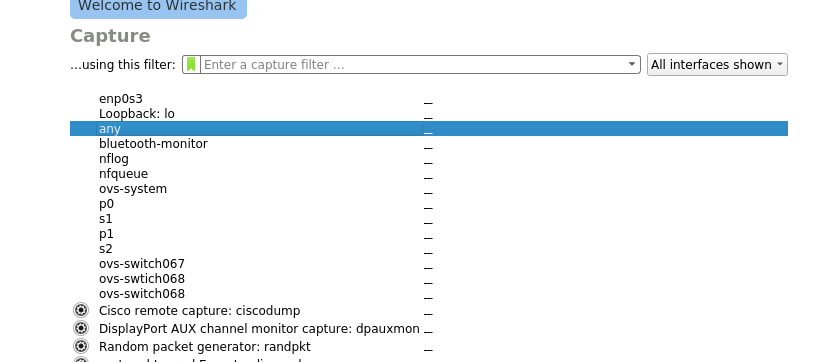
查看抓包结果,分析OpenFlow协议中交换机与控制器的消息交互过程(截图以其中一个交换机为例
OFPT_HELLO 源端口6633 -> 目的端口39980从控制器到交换机

也有源端口39980 -> 目的端口6633的

此处协议为openflow1.5
OFPT_FEATURES_REQUEST 源端口6633 -> 目的端口39980,从控制器到交换机

OFPT_SET_CONFIG 源端口6633 -> 目的端口39982,从控制器到交换机
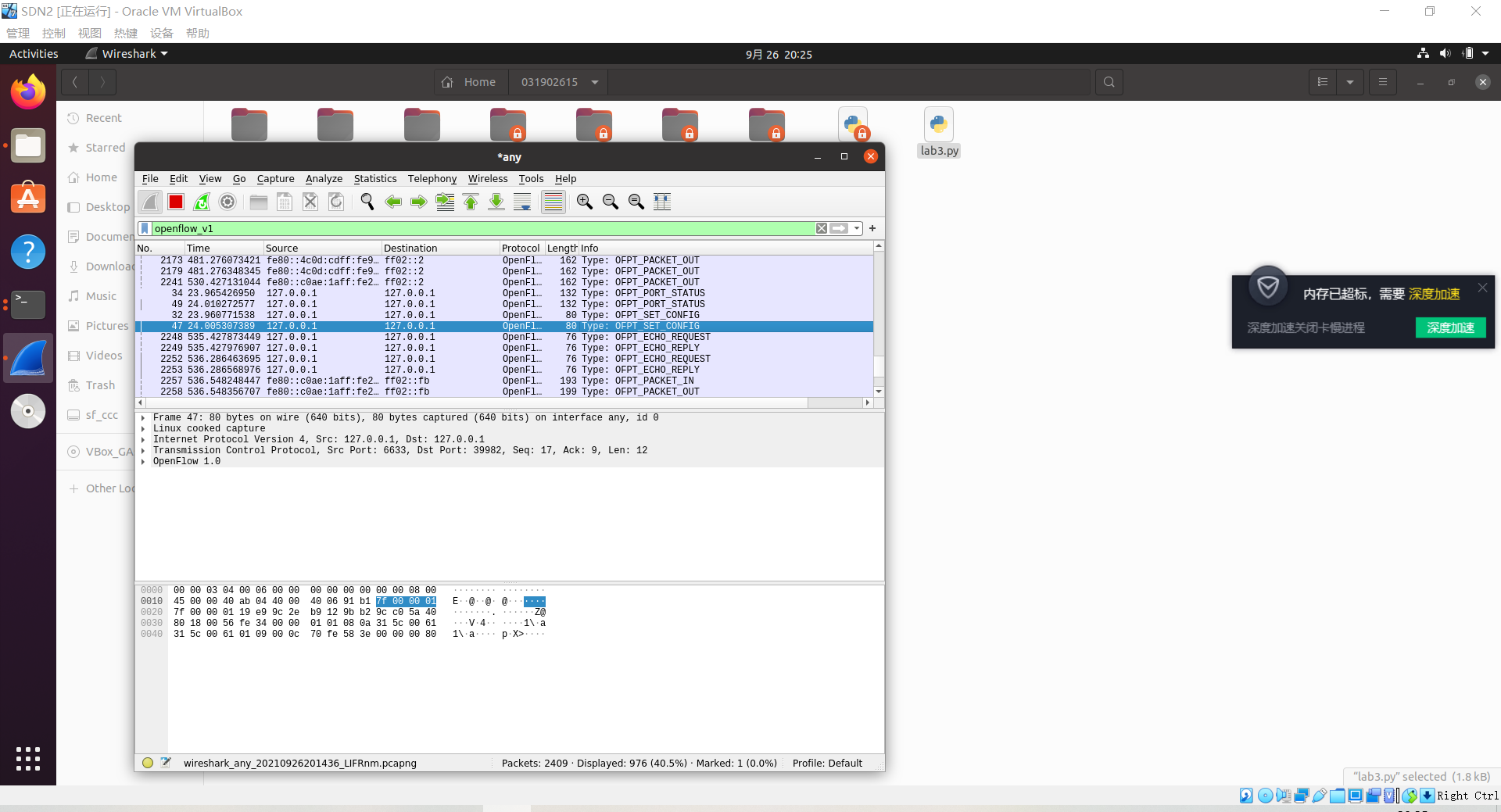
OFPT_PORT_STATUS 源端口39980 -> 目的端口6633,从交换机到控制器

OFPT_FEATURES_REPLY 源端口39980 -> 目的端口6633,从交换机到控制器

OFPT_PACKET_IN 源端口39982 -> 目的端口6633,从交换机到控制器

-
控制器要求交换机按照所给出的action进行处理
- OFPT_PACKET_OUT 源端口6633 -> 目的端口39980,从控制器到交换机

控制器要求交换机按照所给出的action进行处理
-
OFPT_FLOW_MOD 源端口6633 -> 目的端口39982,从控制器到交换机
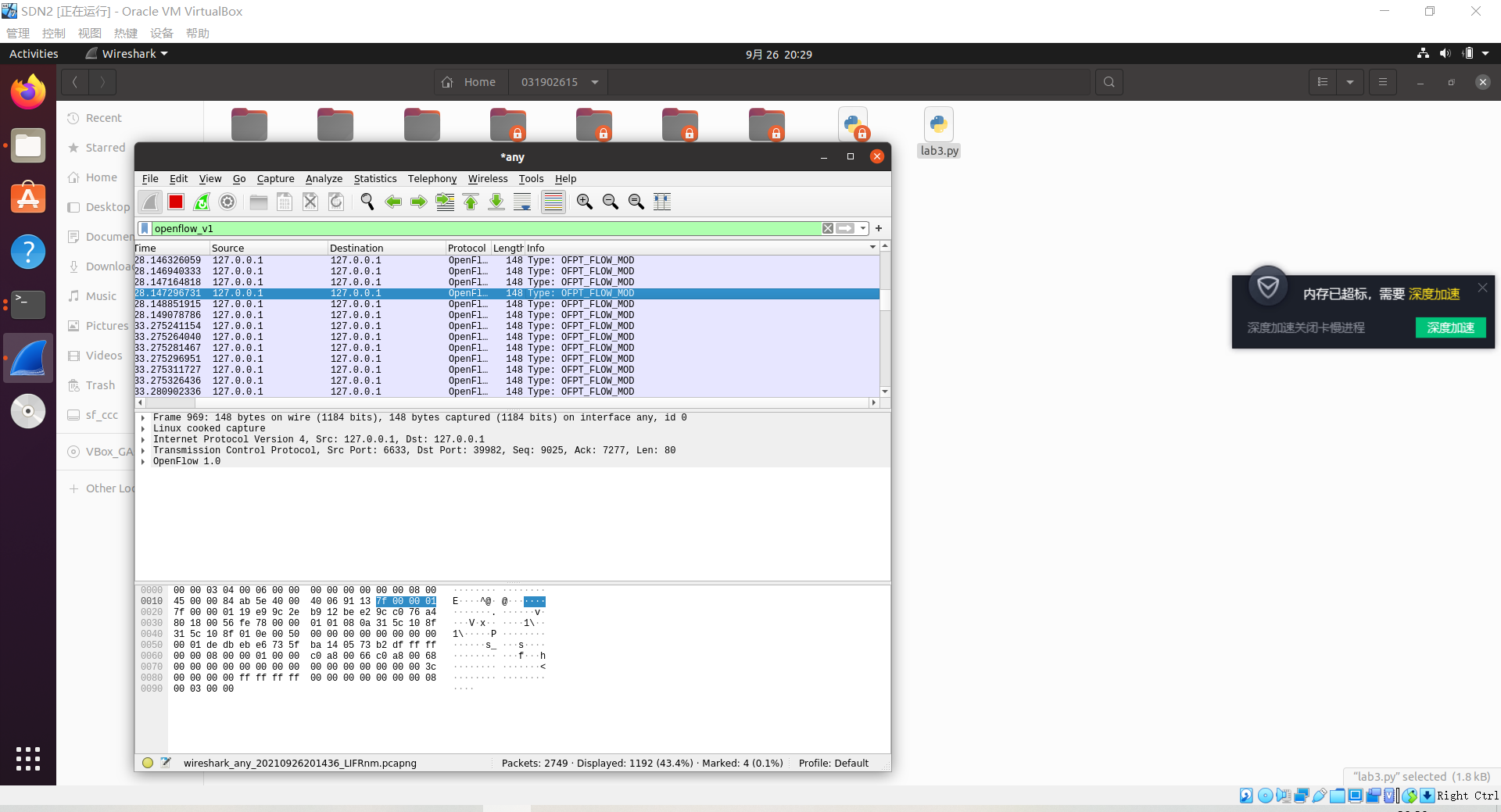
控制器对交换机进行流表的添加、删除、变更等操作
-
画出相关交互图或流程图:
-
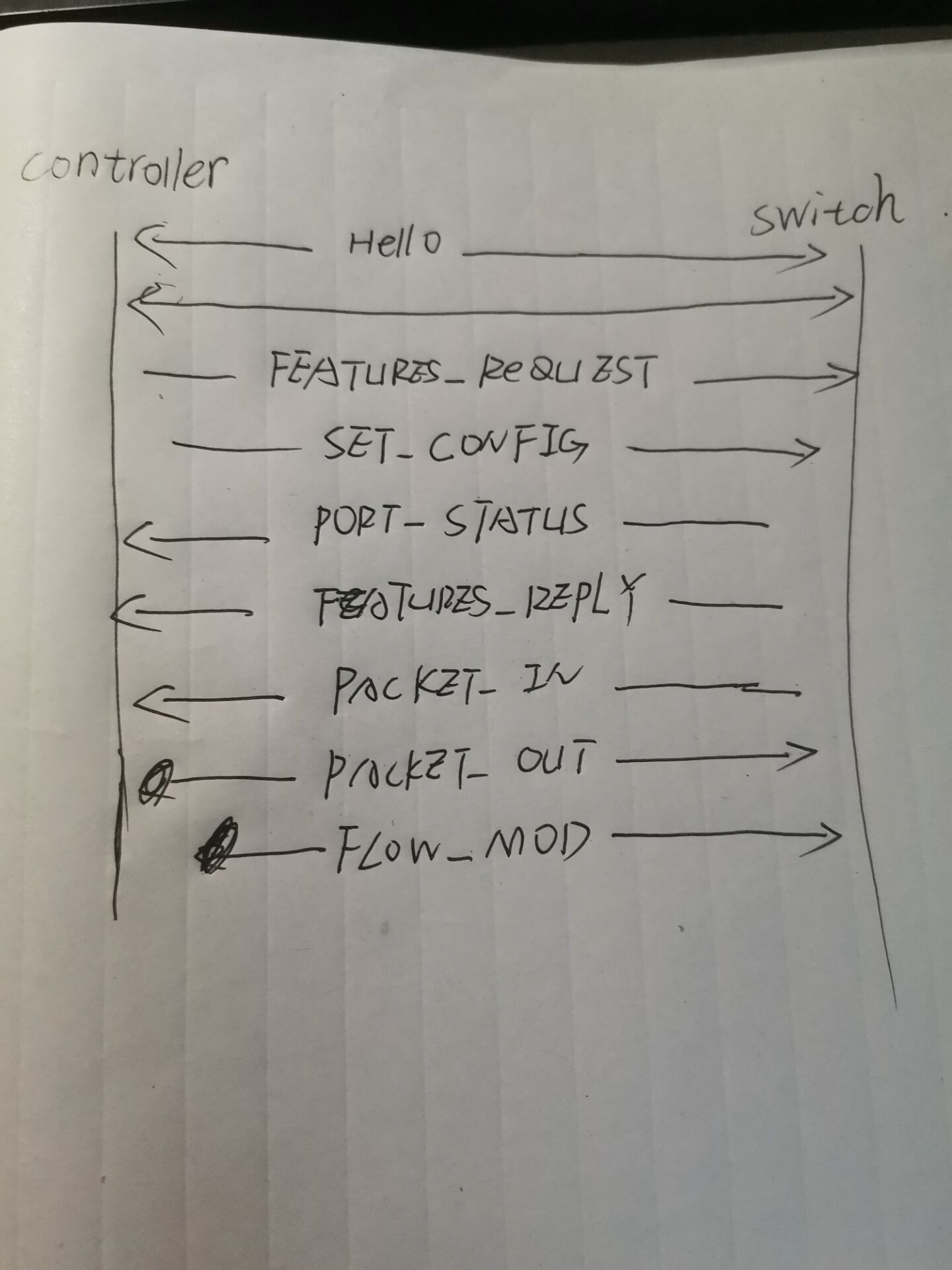
回答问题:交换机与控制器建立通信时是使用TCP协议还是UDP协议?
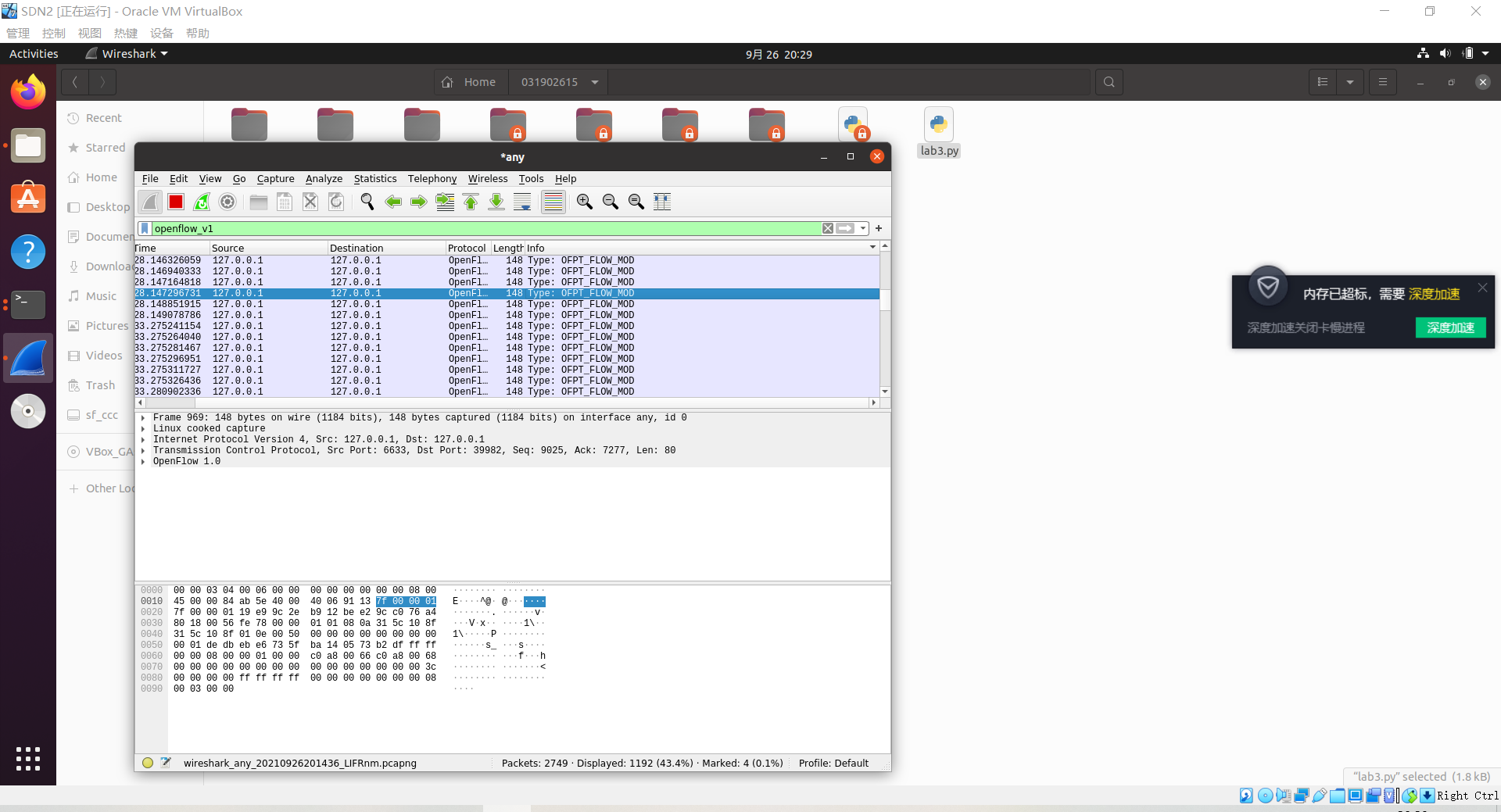
如图所示为(Transmission Control Protocol)TCP协议
-
(二)进阶要求
- 1. HELLO
-
struct ofp_header { uint8_t version; /* OFP_VERSION. */ uint8_t type; /* One of the OFPT_ constants. */ uint16_t length; /* Length including this ofp_header. */ uint32_t xid; /* Transaction id associated with this packet. Replies use the same id as was in the request to facilitate pairing. */ }; struct ofp_hello { struct ofp_header header; };2. FEATURES_REQUEST
源码参数格式与HELLO相同
3.SET_CONFIG/* Switch configuration. */ struct ofp_switch_config { struct ofp_header header; uint16_t flags; /* OFPC_* flags. */ uint16_t miss_send_len; /* Max bytes of new flow that datapath should send to the controller. */ };4. PORT_STATUS
/* A physical port has changed in the datapath */ struct ofp_port_status { struct ofp_header header; uint8_t reason; /* One of OFPPR_*. */ uint8_t pad[7]; /* Align to 64-bits. */ struct ofp_phy_port desc; };5. FEATURES_REPLY
struct ofp_switch_features { struct ofp_header header; uint64_t datapath_id; /* Datapath unique ID. The lower 48-bits are for a MAC address, while the upper 16-bits are implementer-defined. */ uint32_t n_buffers; /* Max packets buffered at once. */ uint8_t n_tables; /* Number of tables supported by datapath. */ uint8_t pad[3]; /* Align to 64-bits. */ /* Features. */ uint32_t capabilities; /* Bitmap of support "ofp_capabilities". */ uint32_t actions; /* Bitmap of supported "ofp_action_type"s. */ /* Port info.*/ struct ofp_phy_port ports[0]; /* Port definitions. The number of ports is inferred from the length field in the header. */ }; /* Description of a physical port */ struct ofp_phy_port { uint16_t port_no; uint8_t hw_addr[OFP_ETH_ALEN]; char name[OFP_MAX_PORT_NAME_LEN]; /* Null-terminated */ uint32_t config; /* Bitmap of OFPPC_* flags. */ uint32_t state; /* Bitmap of OFPPS_* flags. */ /* Bitmaps of OFPPF_* that describe features. All bits zeroed if * unsupported or unavailable. */ uint32_t curr; /* Current features. */ uint32_t advertised; /* Features being advertised by the port. */ uint32_t supported; /* Features supported by the port. */ uint32_t peer; /* Features advertised by peer. */ };6. PACKET_IN
struct ofp_packet_in { struct ofp_header header; uint32_t buffer_id; /* ID assigned by datapath. */ uint16_t total_len; /* Full length of frame. */ uint16_t in_port; /* Port on which frame was received. */ uint8_t reason; /* Reason packet is being sent (one of OFPR_*) */ uint8_t pad; uint8_t data[0]; /* Ethernet frame, halfway through 32-bit word, so the IP header is 32-bit aligned. The amount of data is inferred from the length field in the header. Because of padding, offsetof(struct ofp_packet_in, data) == sizeof(struct ofp_packet_in) - 2. */ };7. PACKET_OUT
struct ofp_packet_out { struct ofp_header header; uint32_t buffer_id; /* ID assigned by datapath (-1 if none). */ uint16_t in_port; /* Packet's input port (OFPP_NONE if none). */ uint16_t actions_len; /* Size of action array in bytes. */ struct ofp_action_header actions[0]; /* Actions. */ /* uint8_t data[0]; */ /* Packet data. The length is inferred from the length field in the header. (Only meaningful if buffer_id == -1.) */ };8. FLOW_MOD
struct ofp_flow_mod { struct ofp_header header; struct ofp_match match; /* Fields to match */ uint64_t cookie; /* Opaque controller-issued identifier. */ /* Flow actions. */ uint16_t command; /* One of OFPFC_*. */ uint16_t idle_timeout; /* Idle time before discarding (seconds). */ uint16_t hard_timeout; /* Max time before discarding (seconds). */ uint16_t priority; /* Priority level of flow entry. */ uint32_t buffer_id; /* Buffered packet to apply to (or -1). Not meaningful for OFPFC_DELETE*. */ uint16_t out_port; /* For OFPFC_DELETE* commands, require matching entries to include this as an output port. A value of OFPP_NONE indicates no restriction. */ uint16_t flags; /* One of OFPFF_*. */ struct ofp_action_header actions[0]; /* The action length is inferred from the length field in the header. */ }; struct ofp_action_header { uint16_t type; /* One of OFPAT_*. */ uint16_t len; /* Length of action, including this header. This is the length of action, including any padding to make it 64-bit aligned. */ uint8_t pad[4]; };
实验总结:
本次实验难度还是比较小的,在实验过程中只要够细心,通过wireshark命令去寻找,还是能很轻松做完的,主要就是一一截图保存比较麻烦。
然后就学习到的内容,这次实验还是很浅显得了解了数据包的交互,第一次画那个交互图的时候,一直以为是双向交互的都是,然后百度了一下,发现错误,然后及时改正了。更多的困难还是需要看一些前辈的博客来进一步理解。



